2019 Best Bow For The Money
Other Reviewed Compound Bows
- Bowtech Fuel
Factors to Consider Before Purchasing
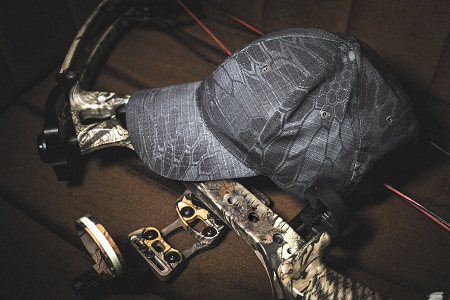
With a wide array of bows on the market, it may be difficult to find the exact one you want.
It is very similar to shopping for a new vehicle. If you don't know what kind of car or truck you want, then with so many decisions, it would be easier to just walk to wherever you want to go.
But, by breaking everything down, the decision almost presents itself "What will be my main use for the vehicle? Work, transportation or play?".
Once you have that figured out, you can narrow your search down and get on the right track for a car or truck.
This same idea applies for archery, "What will my main use for the bow be? Hunting, target shooting, recreation?".
Most people get into archery for competition shooting or hunting.
In this section we focus on features and specifications that make up a good compound bow for hunting.
*If some of the terminology used here leaves you confused or you want to learn more about the technical side of bows, you might want to check out our guide to compound bow parts.
Speed
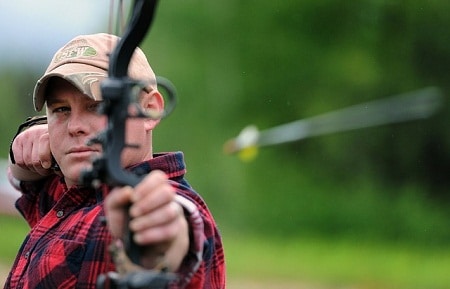
With hunting in mind, it seems that speed is the one thing that grabs a hunter's eye more than anything.
Ten to fifteen years ago, if a bow could shoot over 250 FPS, it was a jaw dropper. With all the current advancements, some bows are now capable of shooting up to 370 FPS.
Jumped String
Anyone who has ever archery hunted seems to have the same story to tell. As soon as they shoot at an animal, the animal moved right before the arrow even hit it. This is called jumped string.
This sickening sight causes any hunter to think back and wish that he or she had a faster bow for it to give better shots, more accuracy, lower arc, and a more ethical kill. With that in mind, it is essential to make sure the bow's speed is right where you want it.
Just to remind you that speed isn't everything.
Achieving Accuracy
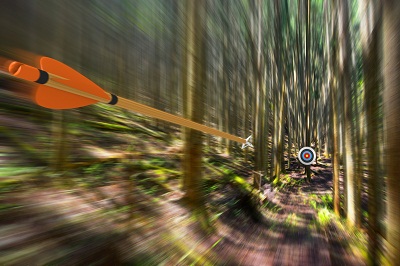
With the thought of "speed isn't everything" in the back of your mind, there is one thing that should be rated higher than speed.
Don't get me wrong. I love the fact that we can shoot as fast as we can. But as long as my bow shoots around 300 FPS, I am shooting an arrow the full length of a football field in one second.
So can I shoot an apple off someone's head the full length of the football field? Of course, I would never try that, but that brings up the next major point — accuracy.
Brace Height
Besides consistency in shooting and a well-tuned bow, brace height plays a huge part in accuracy. It is the measurement from the grip of your bow to the string where you place your arrow. The taller the brace height is, the easier it is to shoot the bow.
However, the taller the brace height is, the slower your bow shoots. So when the brace height is smaller, the faster and less accurate the bow shoots. Before you take less accurate to heart, let me explain.
The majority of shooters find the 7 inches brace height to be optimal, 6 inches are considered as speed bows and 8 inches are competition bows. So anything out of the 6-8 inches range are bows for special purpose.
Focusing On Getting Better
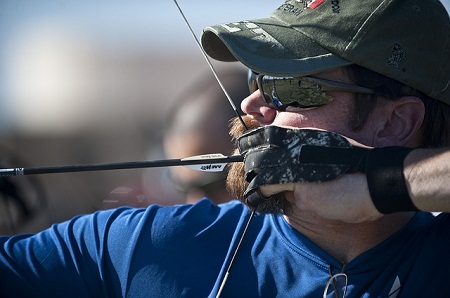
The difference would be similar to me trying to play golf against Tiger Woods when he was in his prime. I could use the same golf clubs that he used and he would have smoked me.
The reason is because his golf clubs were blades, meaning the sweet spot was a lot smaller to hit. So his form had to be perfect for his shot to play out exactly how he wanted it to.
This same example fits perfectly for a small brace height. If you have perfect form and you are able to do the same thing every time, then the brace height won't make much of a difference and you will want a shorter one to help with speed.
But if you torque your wrist or are shaky when in the valley of the draw, then your shooting will suffer immensely.
The main thing is to first learn how to shoot a compound bow properly, and then after a lot of practice you should start worrying about advanced factors like brace height.
My Experience
I have been shooting bows for over 30 years and I still feel that I don't have great form.
I prefer a taller brace height over speed, mainly because if there ever comes a day where I need William Tell a shot and shoot an apple off someone's head at 100 yards, I will have a 1% chance instead of a 0% chance.
Weight
Again, your bow's weight is dependent on your purpose. If your goal is for recreation or target practice, then you can use a heavier bow and set it down between shots.
If it is for hunting, then it is important to note that you will be carrying your bow, gear, arrows and everything else for as long as you are hunting. It can be quite exhausting to carry your hunting gear and to hold your bow up or even at full draw for certain lengths of time.
Now, when a manufacturer advertises the weight of their bow, remember that they are referring to the dry weight. You still have to account for the weight from the sights, arrows plus broadheads, rest, and quiver.
Just a small tip if you plan on hunting, it is suggested to practice shooting your bow with a quiver full of arrows and anything else you might have on your bow when trying to harvest an animal.
Understandably, the amount of weight that the quiver full of arrows is very minimal. But when crunch time comes, muscle memory is all you will have to do as you draw and release your shot.
The weight of the quiver on the side of your bow may not throw you off when shooting something like 30 or 40 yards. But if you are trying to reach out to 60 yards, it may affect you more than you think.
Let-off
Let-off is basically the amount of mechanical relaxation that your bow achieves at full draw, which is measured in percentage. It is usually the same proportion with the bow's peak draw weight.

If your bow is set to 60%, it means that as you draw the bow back it is 60 lbs, but once you get close to full draw the weight reduces. This way you can pull a bow back and hold it at full draw.
This fantastic invention allows the shooter to have time aiming without added shaking if you had to hold the full 60 lbs. This ultimately will increase accuracy.
If you are hunting, then this is the whole reason you are shooting a compound bow — to be able to pull back 60 pounds and hold at full draw for as long as you can until the animal steps out from behind the tree or turns and gives you an ethical shot.
Importance of let-off in hunting
The greater percentage will allow more time at full draw and give you more hunting opportunities instead of becoming fatigued and needing to lower your bow.
Many hunters know that in that moment from when you pull your bow back, you need to hold perfectly still while your heart is beating out of your chest.
If you become fatigued and lower your bow, usually that drastic move will cause the animal to see you and to stop in their tracks. These are reasons why hunters choose a high percentage so they can avoid many disappointing experiences.
Make sure to check your state's rules and regulations as some states have a requirement that a compound bow cannot exceed at a certain percentage of the let-off.
Draw Length

Knowing your draw length will narrow your options and make everything a bit less overwhelming. This is done in different ways but it measures your wing span or one arm up to a certain point.
It gives a great guideline for setting up a bow with what should be comfortable. If you have too long draw length, then you will be pulling the highest poundage a lot of further back into your draw and it will cause other inconsistencies.
A shorter draw length is also hard and requires you to bend your elbow or not get the bow back to your anchor spots against your face.
Choosing the length of draw
I highly recommend getting fitted at a pro shop for any bow you want to buy or even try to shoot. Draw length is probably the most important aspect and setup you need to shoot a bow correctly.
It does not only create consistency but it also greatly reduces injuries like slapping your forearm with the string, to hurting your shoulder if pulling the bow back too far.
Some of the modern compound bows have the ability to adjust the draw length fifteen to twenty inches right there in your living room. Other bows require different cams or machines to change the draw length.
Any pro-staff can easily figure out your draw length with you there in their shop. But here's a simple technique for you:
Draw Weight
Understand that not all bows are versatile when it comes to the poundage. Many bows are designed with a 10-pound adjustment window.
For example, you can purchase a bow that will have the lowest weight setting at 50 pounds and the max that it can be set to is 60. These bows may require different cams or limbs to withstand the new weight. Then there are bows that can be set from 13 to 70 lbs.
Recommended Ranges for Modern Compound Bows
| Very small child (55-70 lbs) | 10-15 lbs |
| Small child (70-100 lbs) | 15-25 lbs |
| Large child (100-130 lbs) | 25-35 lbs |
| Small framed women (100-130 lbs) | 25-35 lbs |
| Medium framed women (130-160 lbs) | 30-40 lbs |
| Athletic older boy kids (130 lbs-150 lbs) | 40-50 lbs |
| Small framed men (120-150 lbs) | 45-55 lbs |
| Large Framed women (160+ lbs) | 45-55 lbs |
| Medium framed men (150-180 lbs) | 55-65 lbs |
| Large framed men (180+ lbs) | 65-75 lbs |
It's also important to have matching arrows for your bow's draw weight, check our article on choosing the best hunting arrows for more information.
State Regulation
Some states have minimum poundage that you must have your bow set to attempt to take big game.
When I first turned ten and was old enough to deer hunt in my state, I knew the minimum poundage for Arizona was 40 lbs. I shot my bow every day and did as many pushups as I could to try to meet that goal.
It took me a couple of years, but I finally got my bow set at that weight.
The reason for the minimum poundage is a great and much needed law. As any true hunter understands, an ethical kill is something that is always desired.
If your bow is shooting a lower poundage and a lower amount of kinetic energy then even with a perfect shot, you may just end up wounding the animal you are after. Just like draw length, some bows can be easily adjusted at home in a matter of seconds.
Sights
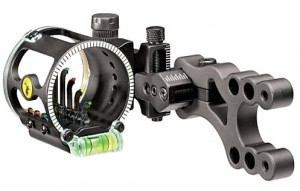
The sights on your bow allow you to pin point how high to hold your bow depending on how many yards you are from your target.
For many, they would have a pin set at 20 yards, the next would be at 30 yards and so on in increments of 10 yards. With the modern advancement in bows, understandably the accuracy has progressed in leaps and bounds. Sights are one of these progressions.
Different Types of Sights
It seems there are more options with different sights than there are with bows. From floating pins to 7 pin setups, the options are limitless.
If your bow doesn't come with a sight, you need to understand the area and style you will be hunting. Tree stand, still hunting, ground blind, spot and stalk. Each sight has a benefit for those different styles of hunting.
7 pin sights are ideal for spot and stock or still hunting. This allows you to approach an animal or jump one and quickly find the pin depending on the distance.
The floating pin or adjustable single pin is perfect for ground blinds or a comfortable tree stand where you can adjust the sight to where the animal may be standing.
Make sure to also read our article on how to sight in a bow.
2019 Best Bow For The Money
Source: https://outdoorempire.com/selecting-compound-bow-reviews/
Posted by: murphynower1969.blogspot.com


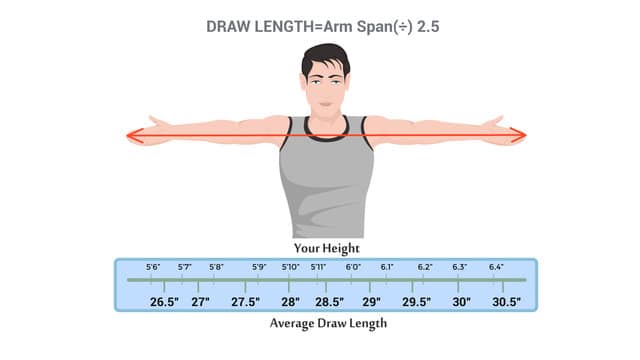
0 Response to "2019 Best Bow For The Money"
Post a Comment